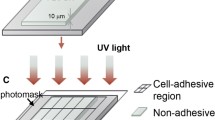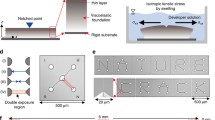Abstract
We have investigated the feasibility of using electrohydrodynamic lithography (EHDL) to produce large lateral areas of patterned polymer substrates for use in biomedical applications. Half centimetered squared regions of uninterrupted patterning were obtained and characterised by profilometry and microscopy. The patterning was found to be elliptical in shape and was composed of concentric bands of distinct patterns centred on initial, randomly located nucleation sites. The size of the patterned area was limited by the degree to which the inter-electrode gap could be kept perfectly parallel, with a difference in height of just 15 nm influencing the patterning. Such sensitivity meant that issues such as the stiffness of the electrodes were important. Hierarchical patterning was achieved by combining EHDL with fracture-induced structuring. The substrates fabricated using EHDL were demonstrated to be viable for cell culture in vitro using fibroblast (3T3) and muscle (C2C12) cell lines.








Similar content being viewed by others
References
Weiss P (1945) Experiments on cell and axon orientation in vitro: the role of colloidal exudates in tissue organisation. J Exp Zool 100:353–386. doi:10.1002/jez.1401000305
Nikkhaha M, Edalata F, Manoucheria S, Khademhosseinia A (2012) Engineering microscale topographies to control the cell substrate interface. Biomaterials 33:5230–5246. doi:10.1016/j.biomaterials.2012.03.079
Kolind K, Leong KW, Besenbacher F, Foss M (2012) Guidance of stem cell fate on 2D patterned surfaces. Biomaterials 33:6626–6633. doi:10.1016/j.biomaterials.2012.05.070
Tsimbouri PM, Murawski KD, Hamilton G, Herzyk P, Oreffo ROC, Gadegaard N, Dalby MJ (2013) A genomics approach in determining nanotopographical effects on MSC phenotype. Biomaterials 34:2177–2184. doi:10.1016/j.biomaterials.2012.12.019
Kim HN, Jiao A, Hwang NS, Kim MS, Kang DH, Kim D-H, Suh K-Y (2013) Nanotopography-guided tissue engineering and regenerative medicine. Adv Drug Deliv Rev 65:536–558. doi:10.1016/j.addr.2012.07.014
Von der Mark K, Park J (2013) Engineering biocompatible implant surfaces. Part II: cellular recognition of biomaterial surfaces: lessons from cell–matrix interactions. Prog Mater Sci 58:327–381. doi:10.1016/j.pmatsci.2012.09.002
Teo BKK, Wong ST, Lim CK, Kung TYS, Yap CH, Ramagopal Y, Romer LH, Yim EKF (2012) Nanotopography modulates mechanotransduction of stem cells and induces differentiation through focal adhesion kinase. ACS Nano 7:4785–4798. doi:10.1021/nn304966z
McNamara LE, Sjöström T, Burgess KEV, Kim JJW, Liu E, Gordonov S, Moghe PV, Meek RMD, Oreffo ROC, Su B, Dalby MJ (2011) Skeletal stem cell physiology on functionally distinct titania nanotopographies. Biomaterials 32:7403–7410. doi:10.1016/j.biomaterials.2011.06.063
Li B, Li Y, Guang-Kui X, Feng X-Q (2009) Surface patterning of soft polymer film-coated cylinders via an electric field. J Phys Condens Matter 21:1–8. doi:10.1088/0953-8984/21/44/445006
Schaffer E, Thurn-Albrecht T, Russell TP, Steiner U (2000) Electrically induced structure formation and pattern transfer. Nature 403:874–877. doi:10.1038/35002540
Goldberg-Oppenheimer P, Kohn P, Langford RM, Steiner U (2012) Patterning of crystalline organic materials by electro-hydrodynamic lithography. Small 8:2595–2601. doi:10.1002/smll.201200194
Wu N, Russel WB (2009) Micro- and nano-patterns created via electrohydrodynamic instabilities. Nano Today 4:180–192. doi:10.1016/j.nantod.2009.02.002
Wu N, Kavousanakis ME, Russel WB (2010) Coarsening in the electrohydrodynamic patterning of thin polymer films. Phys Rev E 81:026306–026319. doi:10.1103/PhysRevE.81.026306
Verma R, Sharma A, Kargupta K, Bhaumik J (2005) Electric field induced instability and pattern formation. Langmuir 21:3710–3721. doi:10.1021/la0472100
Voicu N, Harkema S, Steiner U (2006) Electric-field-induced pattern morphologies in thin liquid films. Adv Funct Mater 16:926–934. doi:10.1002/adfm.200500470
Dickey MD, Collister E, Raines A, Tsiartas P, Holcombe T, Sreenivasan SV, Bonnecaze RT, Wilson CG (2006) Photocurable pillar arrays formed via electrohydrodynamic instabilities. Chem Mater 18:2043–2049. doi:10.1021/cm052592w
Wu N, Pease LF, Russel WB (2006) Toward large-scale alignment of electrohydrodynamic patterning of thin polymer films. Adv Funct Mater 16:1992–1999. doi:10.1002/adfm.200600092
Goldberg-Oppenheimer P, Mahajan S, Steiner U (2012) Hierarchical electrohydrodynamic structures for surface-enhanced Raman scattering. Adv Mater 24:OP175–OP180. doi:10.1002/adma.201104159
Xiang H, Yao L, Russell TP (2004) Electrically induced patterning in block copolymer films. Macromolecules 37:5358–5363. doi:10.1021/ma049888s
Frey MT, Tsai IY, Russell TP, Hanks RS, Wang YL (2006) Cellular responses to substrate topography: role of myosin II and focal adhesion kinase. Biophys J 90:3772–3782. doi:10.1529/biophysj.105.074526
Tian H, Shao J, Ding Y, Li X, Li X (2011) Influence of distorted electric field distribution on microstructure formation in the electrohydrodynamic patterning process. J Vac Sci Technol B 29:41606–41613. doi:10.1116/1.3609808
Voicu NE, Ludwigs S, Steiner U (2008) Alignment of lamellar block copolymers via electrohydrodynamic-driven micropatterning. Adv Mater 20:3022–3027. doi:10.1002/adma.200702970
Chou SY, Zhuang L (1999) Lithographically induced self-assembly of periodic polymer micropillar arrays. J Vac Sci Technol B 17:3197–3202. doi:10.1116/1.590979
Chou SY, Zhuang L, Guo L (1999) Lithographically induced self-construction of polymer microstructures for resistless patterning. Appl Phys Lett 75:1004–1006. doi:10.1063/1.124579
Dickey MD, Raines A, Collister E, Bonnecaze RT, Wilson CG (2008) High-aspect ratio polymeric pillar arrays formed via electrohydrodynamic patterning. J Mater Sci 43:117–122. doi:10.1007/s10853-007-2086-8
Goldberg-Oppenheimer P, Steiner U (2010) Rapid electrohydrodynamic lithography using low-viscosity polymers. Small 6:1248–1254
Pease LF, Deshpande P, Wang Y, Russel WB, Chou SY (2007) Self- formation of sub-60-nm half-pitch gratings with large areas through fracturing. Nat Nanotechnol 2:545–548. doi:10.1038/nnano.2007.264
Eliason MT, Charest JL, Simmons BA, Garcia AJ, King WP (2007) Nanoimprint fabrication of polymer cell substrates with combined microscale and nanoscale topography. J Vac Sci Technol 25:31–35. doi:10.1116/1.2748792
Barbero D, Steiner U (2009) Nonequilibrium polymer rheology in spin-cast films. Phys Rev Lett 102:248303–248307. doi:10.1103/PhysRevLett.102.248303
Vey E, Roger C, Meehan L, Booth J, Claybourn M, Miller AF, Saiani A (2008) Polymer degradation and stability degradation mechanism of poly(lactic-co-glycolic) acid block copolymer cast films in phosphate buffer solution. Polym Degrad Stab 93:1869–1876. doi:10.3390/polym3031377
Hoffman-Kim D, Mitchel JA, Bellamkonda RV (2010) Topography, cell response, and nerve regeneration. Annu Rev Biomed Eng 15:203–231. doi:10.1146/annurev-bioeng-070909-105351
Biela SA, Joachim YS, Spatz P, Kemkemer R (2009) Different sensitivity of human endothelial cells, smooth muscle cells and fibroblasts to topography in the nano-micro range. Acta Biomater 5:2460–2466. doi:10.1016/j.actbio.2009.04.003
Author information
Authors and Affiliations
Corresponding author
Rights and permissions
About this article
Cite this article
Turner, LA., Downes, S., Hill, E. et al. Investigating the suitability of electrohydrodynamic lithography for the fabrication of cell substrates. J Mater Sci 49, 4045–4057 (2014). https://doi.org/10.1007/s10853-013-7971-8
Received:
Accepted:
Published:
Issue Date:
DOI: https://doi.org/10.1007/s10853-013-7971-8




